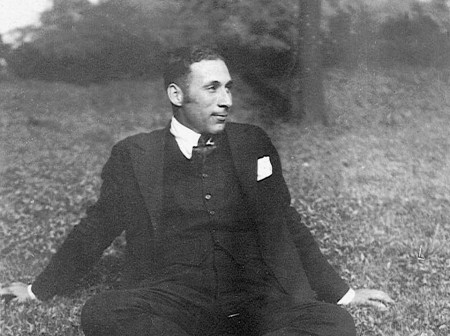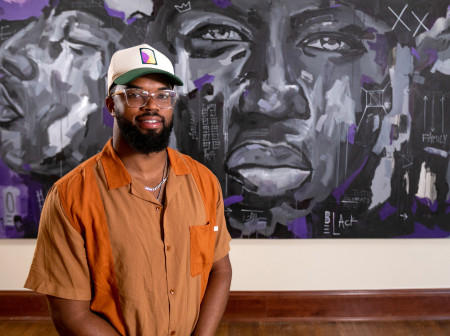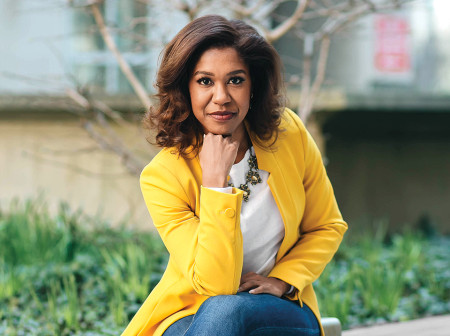Video Transcript:
My name is Charla Wilson and I am the Archivist for the Black Experience at Northwestern University. And I had the privilege of being part of the Black House "curating the space committee" this past year. We worked together to select a few pieces of artwork and photographs of Black student life on campus that are displayed in the Black House. The first floor living room is called the Quibblers Club Family Room. It features a photograph that pays homage to the members of the Quibblers Club, the organization that began in 1926 that was organized as a meeting space and a social outlet for students who commuted to campus. The Quibblers Club organized a number of parties, social gatherings, events for Negro History Week which we refer to as Black History Month and they also invited speakers to come to campus such as literary figures of the time like Langston Hughes.
Throughout the gallery wall in the Black House several photographs represent student athletes at Northwestern and there are two I want to highlight including Clarence Hinton and Bernie Jefferson who were star football athletes in the 1930s. They were also involved in the Quibblers Club where Jefferson attempted to desegregate housing on campus but faced much opposition from white peers who disapproved. After college Jefferson served in World War II as a fighter pilot with the Tuskegee Airmen. He later signed with the Chicago Rockets and thereafter became a teacher and school administrator in Chicago. Hinton attended Howard University's medical school and briefly served in the army and later served a long career as a doctor.
Throughout the gallery wall we have photographs that were taken by alumnus Ronald Craig while he was a student at Northwestern in the early 1970s and he was a student photographer for "Pamoja People," the "Daily Northwestern" and "Syllabus" where we are fortunate that he captured Black student life at that time. His photography also depicted a time when Black students worked with the administration to put the agreement from the Bursar's Office Takeover into action.
Black Greek organizations have provided much needed community and a social outlet for Black students especially when they found themselves excluded from campus social life. The first Black Greek letter organization chartered at Northwestern was Kappa Alpha Psi fraternity in 1917. In earlier years due to low admission of Black students and the housing situation some Greek organizations chartered outside of Northwestern or became inactive on campus for significant periods. The photos here represent some of the early years of reactivated Greek organizations beginning in the 1960s including Kappa Alpha Psi fraternity, Alpha Kappa Alpha sorority and Alpha Phi Alpha fraternity.
So in an attempt to create more opportunities for Black students to get involved in organizations that promoted the arts, alumna Eileen Cherry Chandler was FMO's facilitator for the arts in 1969 and she worked with her peers to create a few of these organizations. She had the vision of creating various artistic outlets that promoted the Black aesthetic and opportunities for self-expression. She worked with peers to organize student groups including Black Folks Theater, Northwestern Community Ensemble, Watu Wazuri dance troupe, and the jazz band The Life and Death Situation and the tradition of the Ritual during orientation.
Northwestern Community Ensemble has ministered to the Northwestern community and beyond since it was founded in 1971. These photographs show the choir during their first concert at the Alice Millar Chapel and in front of Ebenezer AME Church in Evanston. In the 1970s the choir demonstrated the importance of having a diverse music curriculum and Black faculty especially in the aftermath of the Bursar's Office Takeover to become a campus recognized student group and to use choir rehearsal spaces they needed a faculty advisor. However at the time the campus did not have a faculty member who specialized in Black sacred music so students ultimately decided to support themselves as an independent student group for its first 10 years and established a relationship with Evanston area churches but specifically Ebenezer AME Church to utilize their space for rehearsals. There's also a photograph of the reunion choir in 2018 during the Bursar's Office Takeover commemoration program in the Alice Millar Chapel.
So we would be remiss if we did not acknowledge the history of student activism on campus. After all the Black House would not exist without the 1968 Bursar's Office Takeover. Throughout the gallery there are several images that represent student activism on campus including the 1968 Bursar's Office Takeover, the 1969 hunger strike as well as protests against apartheid and South Africa and the National Black Student Action Day protest in the late 1980s calling for increased recruitment and retention of Black faculty, students and administrators.
One of the hidden gems in the Black House is the artwork created by black artists such as Varnette Honeywood, which were selected by former Department of African American Student Affairs staff. It also features student-created work from the 1970s to the present. Overall the beautiful artwork brings much character to the space and connects the Black American history and culture. The Black House has several pieces created by AfriCOBRA artists from the Black Arts Movement of the mid-1960s to mid 1970s devoted to creating uplifting revolutionary art that celebrated Black American history and culture.
So I found the artwork, the photographs, the many stories that represent Black student life to be incredibly inspiring and I hope that through this video you have also been able to experience that as well.



Reader Responses
No one has commented on this page yet.
Submit a Response